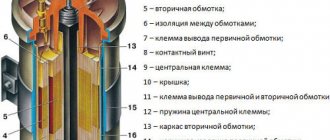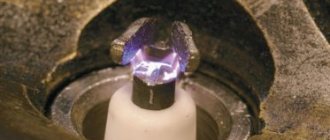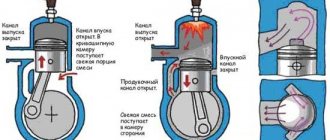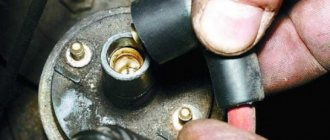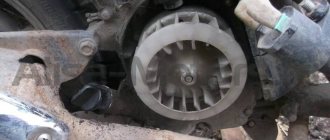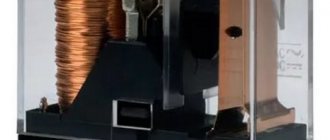If there is no spark in your car's engine (injection or carburetor), it will stall or not want to start at all. This is not surprising, since if there is no spark on one or more spark plugs, the ignition process does not occur in the engine cylinders, and the fuel simply flies into the exhaust pipe. In this article we will look at the main reasons why the spark disappears. You will also learn which elements of the ignition system need to be checked in case of such a malfunction and how to solve the problem.
Typical causes of spark loss
Depending on the type of powertrain, there are several factors that can cause the spark plugs to fail to spark. In most cases the reasons are as follows:
- Low battery.
- Damage or failure of spark plugs. They can also be filled with gasoline or oil.
- Malfunction of the module, switch or ignition coil.
- Poor contact or damage to the insulating layer of high-voltage wires.
- Malfunction of the crankshaft position sensor (CPS).
- Malfunctions in the operation of the distributor.
- Problems in the low voltage circuit.
- Poor ground contact.
- Malfunctions in the operation of the engine ECU (electronic control unit).
Switch
With a switch the situation is somewhat more complicated. The fact is that it is impossible to check it yourself. The best solution here would be to replace the device with a known good one.
Having determined that in the area before the distributor, we can immediately conclude that the reason for this is the switch. This is the most capricious device in the entire ignition system. It can “burn out” due to the slightest voltage drop caused by a malfunction of the generator, faulty spark plugs or high-voltage wires. This is why some experienced Samar drivers carry a spare device with them.
Battery diagnostics
The most common reason is a dead battery. If the indicators on the instrument panel dim when you turn the ignition key to start the engine, the battery is discharged. Sometimes the reason lies in poor contacts at the battery terminals. These problems can be solved simply:
- if the battery is simply discharged, you need to recharge it or replace another battery;
- if the problem is in the terminals, it is necessary to thoroughly clean them from corrosion and tighten them securely (to avoid further oxidation, it is recommended to apply graphite lubricant to the contacts).
Methods for checking an injection and carburetor engine in the absence of a spark
If there is no spark on the engine, different diagnostic methods are used:
- checking for ground;
- checking with a digital multimeter (tester);
- using a special tester with a piezoelectric element.
It is recommended to use the ground test only on vehicles with a carburetor. To do this, you need to take a spark plug and bring it to any metal part of the engine (the cylinder block is good). Another person in the cabin should try to start the engine by turning the key in the ignition. This determines the supply of a spark to a specific spark plug.
Important! It is not advisable to use this method to check the spark on injection machines, since they use expensive electrical equipment that can fail due to such “diagnostics”.
Using a multimeter allows you to check the spark plugs themselves. The diagnostic principle does not differ from the first method, but the likelihood of damage to the engine ECU is minimized. A special device called a “discharger” allows you to check the spark on a carburetor engine. Using such a device, you can easily determine in which segment of the car's ignition system there are problems.
If there is no spark in all cylinders, the culprit may be the controller, ignition coil/module, or center wire. First you need to check the condition of the fuses. After this, we check the ground connection and high-voltage wires.
If there is no spark at the coil, you need to check the condition of the central high voltage wire. The presence of damage to the insulating layer, breakdowns and other defects is unacceptable. If they are found, this element must be replaced.
In addition, while searching for a spark, do not forget to check the spark plugs. But it is advisable to do this only after you have reliably established that the spark definitely reaches the spark plugs. The check is performed using the method mentioned above. The spark should be white with a slightly bluish tint. If there is a spark, but it is weak, check the condition of the spark plug contacts. In any case, replacing spark plugs is inexpensive, so it won’t be superfluous.
What is ASZ
ATTENTION! A completely simple way to reduce fuel consumption has been found! Don't believe me? An auto mechanic with 15 years of experience also didn’t believe it until he tried it. And now he saves 35,000 rubles a year on gasoline!
There may be several reasons for the lack of sparking. Most often, the culprit is the distributor with its elements. But no less well-known reasons are: a bad battery, the armored wires themselves, the ignition coil or its winding.
As you know, the car ignition system or ASZ is designed to effectively ignite fuel. It is clear that without a spark there can be no talk of any ignition. It is not for nothing that the ASZ of a gasoline engine is also commonly called a spark ignition system.
Depending on the type of process control, there are several gas stations. On domestic classics, for example, a contact ASZ is used, and on foreign cars - transistor or electronic.
The distributor in the contact ASZ plays the role of a current and energy distributor across the cylinders. At the same time, it acts as a current energy storage device.
If in a contact ASZ accumulation and distribution are carried out in a single mechanism (distributor), then in a BASS (transistor system) a switch is responsible for accumulation, clearly interacting with the Hall sensor. As for the distribution of energy, it is still controlled by the distributor.
It is noteworthy, but in most cases the spark disappears at the most inopportune moment. For example, if you urgently need to go somewhere in your car.
Checking the ignition coil for spark
It is necessary to remove the wire from the distributor. After this, the wire must be brought to the metal element and the engine rotated with the starter. If there is a spark, then the ignition distributor-distributor has failed. If it is not visible, you need to proceed to checking the coil.
If the problem is in the distributor, you need to start checking with its contacts. Problems can be caused by oxidation, breakdowns in the insulating layer, or rotor malfunctions. If you notice problems with the rotor, it must be replaced with a new element.
When diagnosing the ignition coil, check the condition of the winding. Usually the lack of spark is caused by a short circuit inside this part. If you find any signs of it, we advise you to buy a new coil and install it on your car. Also, the ignition coil can be damaged by overloads caused by faulty high-voltage wires or spark plugs.
Checking the coil is done as follows:
- the car must be parked in a dry room;
- it is necessary to remove dirt from the ignition distributor-distributor cover and remove it;
- turn the engine crankshaft so that the distributor contacts are in the closed position;
- turn on the ignition and bring the high-voltage wire of the distributor 3-7 mm to the metal part of the engine.
This will also tell you if the ignition coil needs replacing. The most suitable option is to test the coil on special equipment in workshops. This procedure checks the operation of the coil in different modes.
To check the spark on the spark plugs, you need to unscrew them. Pay attention to the condition of the contacts, the presence of carbon deposits or oil. All elements of dirt must be removed before performing the diagnosis. Do not forget about the correct gap between the electrodes. If a discrepancy is detected, the side electrode is carefully bent. Like the coil, spark plugs can only be properly checked using special equipment.
The old-fashioned way of “revitalizing” a contact
That's usually how it goes. Yesterday the car was fine, it started the first time. In the morning - like “dead”. Any motorist who understands cars will remove the spark plugs, inspect and check them first. No spark.
Further checking is carried out on the coil. It is necessary to inspect the main armored wire to see if current flows through it. No spark again?
Here's what to do:
- Check if current is flowing to the bobbin (coil).
- Check if voltage is going to the switch.
If there is voltage, but the spark does not go through the armored wire, the first doubt falls immediately on the woman. She is removed, checked thoroughly, and called. Is she working? It would seem like an opportunity? But this happens often. Don't panic.
And here the distributor itself, the distributor, comes to the fore. It is dismantled, the hall sensor is removed, cleaned of oil (sometimes it gets inside).
As a rule, these actions are enough for a spark to reappear on cars with a non-contact ignition system (non-contact ignition system), where the distributor becomes the “culprit” for the voltage loss. And the reason that the spark has disappeared is either oil getting into the sensor or a loose contact.
This often happens: the wires/communications connecting the switch and distributor provide unreliable, weakened contact. The old “old-fashioned” method of touching everything with your hands is 100 percent effective here. In this way, you can “reanimate”, “revive” the contact.
This method will help you save on the purchase of a coil, hall sensor or switch. It is not uncommon for amateurs in car service centers, who have little understanding of the matter, to send the car owner to the store for parts that are actually in full working order.
No spark - checking the ignition module
Possible signs of ignition module failure:
- engine tripping at idle;
- drop in power, poor acceleration dynamics.
If the wires and spark plugs are ok, you need to test the ignition module. We connect one multimeter probe to the module connector, and connect the second to ground. After this we try to start the engine. If the device display shows a value of about 12V, the module is working.
Make sure there is no spark
- Disconnect the fuel system by removing the fuel pump fuse or relay.
- Insert the spark plug tester into the plug and ground it to the engine.
- Have someone crank the engine and watch for spark.
If you have a coil-on-plug ignition system without wires
- Remove one of the coils from the spark plug.
- Use an old spark plug.
- Spark plug tester.
- Or even a screwdriver in the coil plug.
- Ground to a metal part of the engine.
- Have someone spin the engine and watch for a spark.
No spark indicates an ignition problem.
In extreme cases, the control unit (ECU) may malfunction. In some cases, a problem with the ECU can cause the car to not run at all. The functions of the control unit include crankshaft positioning, spark control and ignition timing. If there are problems with the way the controller performs these functions, the vehicle may not operate.
Low Voltage Circuit Diagnostics
For this method, you need to find a test lamp with a power of 2-3 Watts and a voltage of 12V. We connect one contact of the lamp to the low voltage contact of the distributor, and the second to ground.
The next step is to close the contacts of the distributor and turn on the ignition. If there are no problems in the low voltage circuit, the lamp will go out when the contacts are closed and light up when the contacts are open. If opening the contacts does not cause the lamp to glow, the cause of the breakdown is the primary winding of the coil or low voltage wire.
If the lamp glows continuously, regardless of the position of the contacts, this indicates the following possible breakdowns:
- oxidation of distributor contacts;
- damage to the wire connecting the distributor body and its movable disk;
- damage to the wire between the lever and the distributor terminal.
How to check for spark?
To verify that the engine is not starting due to lack of spark, you can do one of the following.
Ignition voltage is dangerous! Do not hold or touch the spark plug wire while starting the engine.
If the spark plugs come with wires, disconnect one of them from the spark plug and place the end of the wire near a metal surface on the engine. Insert a small Phillips screwdriver, small bolt, or nail into the end of the wire (lug) to provide a conductive path. Then spin the engine and check for spark between the screwdriver, bolt or nail in the spark plug wire tip and the engine housing. If there is no spark, then there is an ignition problem.
Another option. Disconnect the spark plug wire and insert an old spark plug or ignition tester into it. Place the spark plug on a metal surface of the engine or ground the spark plug tester. Then spin the engine. No spark indicates an ignition problem.
If you have a separate ignition coil for each plug, disconnect one of the coils from the spark plug and insert an old spark plug, spark plug tester, or screwdriver into the end of the coil. Ground the spark plug or spark plug tester to the engine, then crank the engine and check for spark. The absence of a spark indicates an ignition problem.
Video on how to check the spark on an injection engine:
Spray some Quick Start aerosol into the throttle body (WARNING: Quick Start fluid is extremely flammable!). Then crank the engine.
If the engine starts, you have no ignition problems. The engine failure is fuel related.
